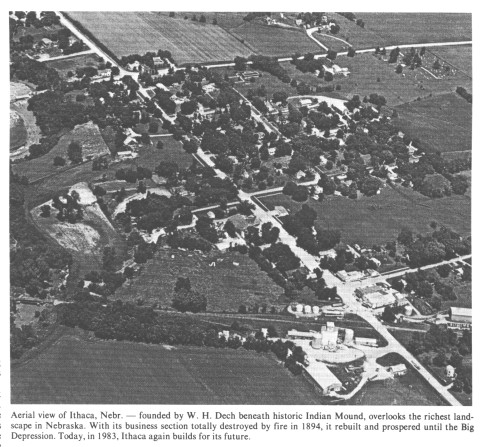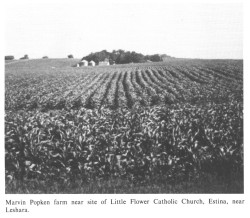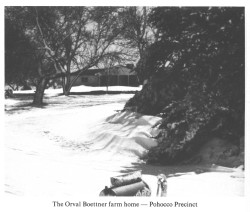|
was organized and continues each summer.
In 1941, the parsonage was modernized with running water, new kitchen cabinets and a bathroom.
By 1943, the building fund had only increased to $113.63. Two cash rallies a year were held so that the new building could be erected by the close of World War II. The first rally added $1443.
On Nov. 16, 1946, the Evangelical United Brethren Church was organized in Johnstown, Pa.
The Zion and the Ebenezer Churches were united in 1948 with a membership of 180.
By 1950, $21000 had been subscribed and added to the $22,000 which had accumulated and the Nebraska Conference granted $7000 for our new church. Ground was broken on August 11, 1950. The cornerstone was laid May 6, 1951, and the new church was dedicated on December 16, 1951. The men and women of the church contributed many hours of hard work. The cost was $65,000.
A brick that was picked up from the rubble of Jacob Albright's brickmaking yard in Johnstown, Pa. can be seen on the front of the church just below the cross. Jacob Albright was the founder of the Evangelical Church.
The ladies of the W.S.W.S. purchased the equipment for the kitchen and the Sunday School and Youth Fellowship grew strong. The Y.F. soon began holding ice cream socials and soup suppers.
The parsonage was remodeled and electric heat was installed.
Six more young men made their decision to enter the ministry when they were members of this church. They were Wm. Arnold, Gary Frahm, Lynn Hageman, Vernon Robbins, Gerald Schwab and Melvin Vance.
Once again churches began planning a union and on May 26, 1968 both the Evangelical United Brethren Church and the Methodist Church approved the union.
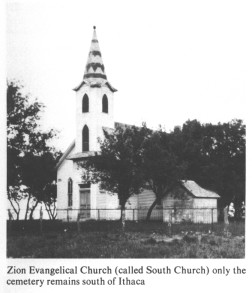 |
| Zion Evangelical Church (called South Church) only the cemetery remains south of Ithaca |
THE ITHACA METHODIST
STORY
1881 - 1968
On April 21, 1850, the first Methodist sermon was given in Omaha Nebraska. In 1956, the Kansas-Nebraska Methodist Conference was formed. Ten years later Ithaca was a part of the South Platte Circuit.
Twenty-five members under the leadership of Rev. A. Madole on the Rock Creek Circuit organized the first Methodist Church in Ithaca in 1881. A parsonage was built the first year. Services were held in the school house.
In 1885, Ithaca separated from Rock Creek Circuit. A deed for the location of the Methodist Church with the consideration of one Dollar was made by Hannah Deck. Labor was furnished by the members and the church was dedicated in the fall of 1886 by Rev. Hackney, a former minister.
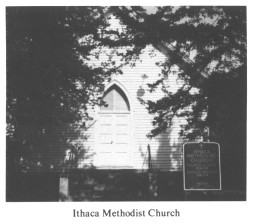 |
| Ithaca Methodist Church |
During 1891, the Epworth League was introduced in the conference. Ithaca had 26 charter members.
In June 1892, the trustees paid $40 to Elizah Enbody and wife for a lot for relocating the parsonage. The parsonage was moved to the new location in the fall of 1893.
In 1898, a new barn was built. In 1919, a basement was put under the church. Over 300 persons were served at the first dinner. At evening services that day 17 children and infants and five adults were baptised and 7 adults were received into membership.
In 1931, the barn was replaced with a garage at the cost of $65.
In 1934, it was reported the church was unable to pay a full salary to the Pastor for the third consecutive year. A note in an old record book says "a number of members were transferred to Evangelical Church on account of trouble through the Klu Klux Klan.
Things were looking up in 1935, an Epworth League and Scout Troop were organized. Membership increased and in 1936 a Junior League was organized.
The God's Acre program was introduced in 1938. About 900 bushels of corn was cribbed on the parsonage lot. Badly needed improvements were made.
From 1953-1966 Rev. Ralph Rassmussen's leadership was the longest in the church's history.
Membership declined and there was no Sunday School, but the congregation was meeting its full obligations to annual conference and had an active Women's Society of Christian Service when LeRoy E. Seaver was appointed in 1966.
At National level Methodist and Evangelical United Brethren churches were on the verge of union. It was approved on April 23, 1968. The Ithaca Methodist and Evangelical United Brethren churches approved the union. On June 30, 1968, at a special service uniting the two churches, they became the United Methodist Church of Ithaca, Nebraska. The parsonage had been sold, and after the union, the church building, ground, and personal property not used in the United Methodist Church was sold at a public auction.
The church building sold for $50. The buyer later sold it and today it is a part of Ithaca District #50 school house.
HISTORY OF ITHACA UNITED
METHODIST CHURCH
On February 4, 1968, a joint EUB -- Methodist Church Conference was held in the EUB Fellowship Room. District Superintendents Max McCamley and John Wichelt were present. The already-appointed working committee was asked to draw up a "Plan for Union". This committee consisted of Pastors LeRoy Seaver and Harvey Schwab, LaVerne Gustafson, Garnet Meese, Robert Wagner, Faith Smith, Earl Hageman, and Wallace Quick. The proposed plan was submitted to each congregation on May 26, 1968 and was strongly endorsed. The union was cemented in an impressive service on June 30, 1963. The new church was named The United Methodist Church of Ithaca.
Other changes were experienced in 1968. Pastor Harvey Schwab retired from the active ministry and moved to Wahoo. His replacement in the Ithaca parsonage was Rev. John Foley, a recent seminary graduate. Ithaca also became part of an enlarged charge with Pastor Foley serving the Ceresco congregation. There were 191 adult members at the close of 1968, and over 50 young people between the ages of 12-18.
Rev. Foley left in 1970 to become Executive Director of the Nebraska Association for Retarded Citizens. Rev. Eugene Beye and family moved into the Ithaca parsonage in June, 1970.
In the spring and summer of 1971, the parsonage received a complete remodeling. A total of $5,654 was spent to redo the entire downstairs portion of the house. As had occurred so often before, the cost was reduced due to much volunteer labor. A parsonage Open House was held on November 7, 1971.
Lent of 1972 found the Ithaca Church involved in an ecumenical preaching series. This cooperative effort continues and included six Lutheran, Covenant, and Methodist churches in the Ceresco-Ithaca area. It brought outstanding preachers and much inspiration to the communities.
Rev. Beye left Ithaca on Oct. 15, 1973, and assumed the pastorate at Creighton, NE. This left the Ceresco-Ithaca charge with no pastoral leadership for 4 ½ months. Rev. Dennis Murphy, an instructor at Wesleyan, was secured to preach on Sundays.
On March 1, 1974, Rev. Charles Leypoldt began serving the Ceresco-Ithaca churches. Rev. Leypoldt and his family resided in Ceresco. The Ithaca parsonage became rental property.
In 1975, the Ithaca church ranked 2nd among all United Methodist churches in Nebraska in their response to ONE GREAT HOUR OF SHARING. A new social group, the NIGHTENGALS, was organized for the younger women of the church.
In 1978, Rev. Leypoldt left Ithaca to serve the Douglas-Burr Methodist churches. Rev. Ed Morrison became the new pastor, and Ithaca became part of the Wahoo parish.
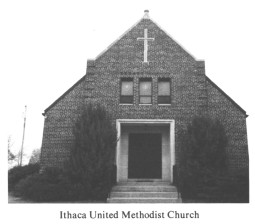 |
| Ithaca United Methodist Church |
On October 11, 1981, the Ithaca United Methodist Church celebrated their centennial. Many former members and friends were on hand to spend the day in worship and remembering. Many former pastors were present to share their memories. Special recognition was given to Robert and Ronda Treptow, Staci and Kris Hass, Traci and Terri Lamprecht, Mark and Becky Teetor, Travis and Deric Hanke, Jason, Kristin, and Tara Girmus Heath Smith and Jill Chaput for being 5th generation members of the church. 50 year pins were presented to Anna and Edward Frahm, LaVerne Gustafson, Ray Hageman, Vera Hageman, Dale Noerenberg, Fay Schiefelben, Clara Treptow, and Lorene Treptow. Special recognition was also given to Alma Hageman and Albert Hageman for members for 76 years and 80 years respectively.
Throughout the years the UMW has given faithful service where needed. The church parlors have
page 155
| 



